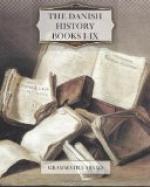Woden had a son Balder, rival of Hother for the love of Nanna, daughter of King Gewar. Woden and Thor his son fought for him against Hother, but in vain, for Hother won the laity and put Balder to shameful flight; however, Balder, half-frenzied by his dreams of Nanna, in turn drove him into exile (winning the lady); finally Hother, befriended hy luck and the Wood Maidens, to whom he owed his early successes and his magic coat, belt, and girdle (there is obvious confusion here in the text), at last met Balder and stabbed him in the side. Of this wound Balder died in three days, as was foretold by the awful dream in which Proserpina (Hela) appeared to him. Balder’s grand burial, his barrow, and the magic flood which burst from it when one Harald tried to break into it, and terrified the robbers, are described.
The death of Balder led Woden to seek revenge. Hrossthiof the wizard, whom he consulted, told him he must beget a son by “Wrinda” (Rinda, daughter of the King of the Ruthenians), who should avenge his half-brother.
Woden’s wooing is the best part of this story, half spoilt, however, by euhemeristic tone and lack of epic dignity. He woos as a victorious warrior, and receives a cuff; as a generous goldsmith, and gets a buffet; as a handsome soldier, earning a heavy knock-down blow; but in the garb of a women as Wecha (Wakr), skilled in leechcraft, he won his way by trickery; and ("Wale”) “Bous” was born, who, after some years, slew Hother in battle, and died himself of his wounds. Bous’ barrow in Bohusland, Balder’s haven, Balder’s well, are named as local attestations of the legend, which is in a late form, as it seems.
The story of Woden’s being banished for misbehaviour, and especially for sorcery and for having worn woman’s attire to trick Wrinda, his replacement by “Wuldor” ("Oller"), a high priest who assumed Woden’s name and flourished for ten years, but was ultimately expelled by the returning Woden, and killed by the Danes in Sweden, is in the same style. But Wuldor’s bone vessel is an old bit of genuine tradition mangled. It would cross the sea as well as a ship could, by virtue of certain spells marked on it.
Of “Frey”, who appears as “satrapa” of the gods at Upsala, and as the originator of human sacrifice, and as appeased by black victims, at a sacrifice called Froblod (Freys-blot) instituted by Hadding, who began it as an atonement for having slain a sea-monster, a deed for which he had incurred a curse. The priapic and generative influences of Frey are only indicated by a curious tradition mentioned. It almost looks as if there had once been such an institution at Upsala as adorned the Phoenician temples, under Frey’s patronage and for a symbolic means of worship.
“Thunder”, or “Thor”, is Woden’s son, strongest of gods or men, patron of Starcad, whom he turned, by pulling off four arms, from a monster to a man.




